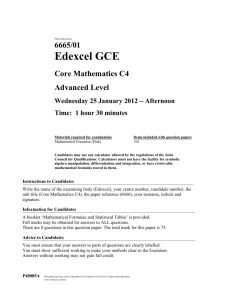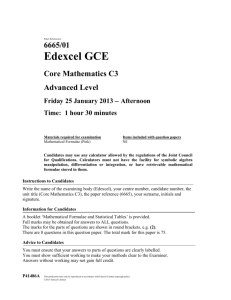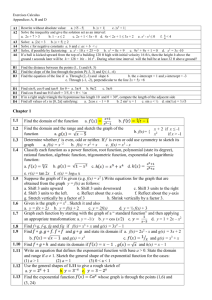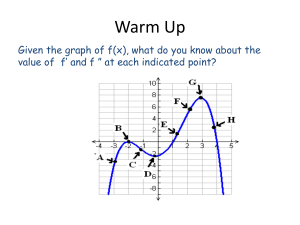Solutions to Reinforcement Exercises in Applications of
advertisement
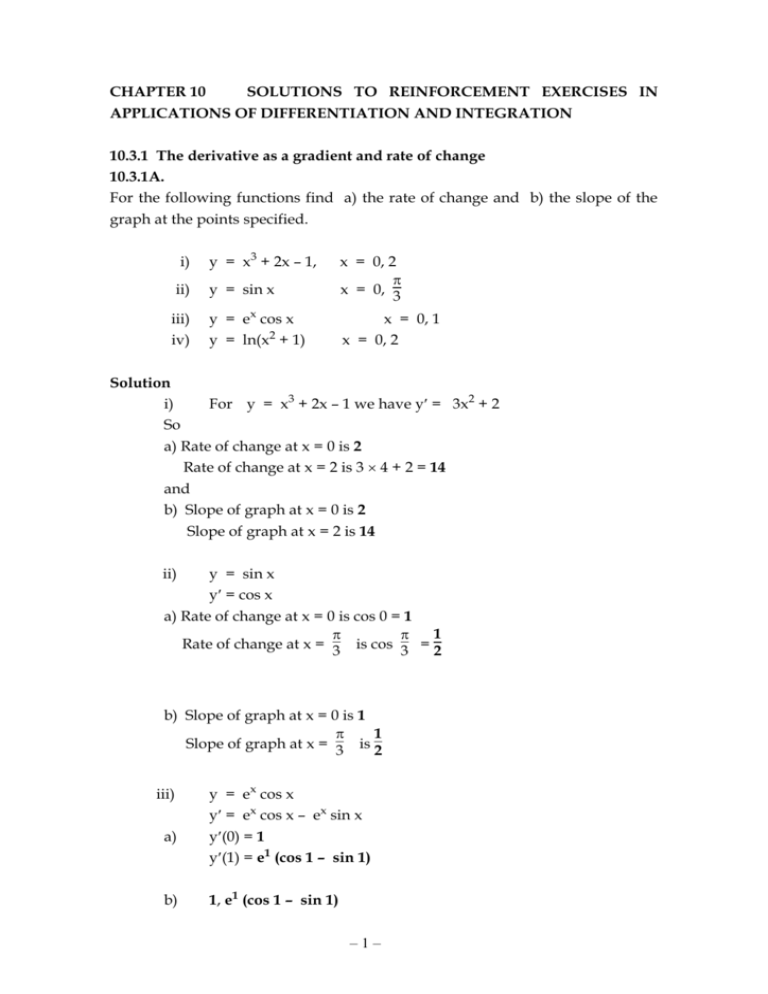
CHAPTER 10 SOLUTIONS TO REINFORCEMENT EXERCISES IN APPLICATIONS OF DIFFERENTIATION AND INTEGRATION 10.3.1 The derivative as a gradient and rate of change 10.3.1A. For the following functions find a) the rate of change and b) the slope of the graph at the points specified. i) y = x3 + 2x – 1, ii) y = sin x x = 0, 2 x = 0, 3 iii) iv) y = ex cos x y = ln(x2 + 1) x = 0, 1 x = 0, 2 Solution i) For y = x3 + 2x – 1 we have y = 3x2 + 2 So a) Rate of change at x = 0 is 2 Rate of change at x = 2 is 3 4 + 2 = 14 and b) Slope of graph at x = 0 is 2 Slope of graph at x = 2 is 14 ii) y = sin x y = cos x a) Rate of change at x = 0 is cos 0 = 1 1 Rate of change at x = 3 is cos 3 = 2 b) Slope of graph at x = 0 is 1 1 Slope of graph at x = 3 is 2 iii) a) b) y = ex cos x y = ex cos x – ex sin x y(0) = 1 y(1) = e1 (cos 1 – sin 1) 1, e1 (cos 1 – sin 1) –1– y = ln(x2 + 1) 2x y = 2 x +1 iv) a) y(0) = 0 4 y(2) = 5 4 0, 5 b) 10.3.1B. Find the point on the curve y = x3 + 3x2 – 9x + 1 where the gradient is – 12. Solution If y = x3 + 3x2 – 9x + 1 then y(x) = 3x2 + 6x – 9 is the gradient at any point x. So the gradient is – 12 where 3x2 + 6x – 9 = – 12 ie 3x2 + 6x + 3 = 0 or x2 + 2x + 1 = (x + 1)2 = 0 So there is only one such point, at x = – 1, where the value of y is y(– 1) = (– 1)3 + 3(– 1)2 – 9(– 1) + 1 = 12 So the gradient is – 12 at (– 1, 12) 10.3.2 Tangent and normal to a curve Find the equations of the tangents and the normals to the following curves at the points indicated. i) y = x2 + 2x – 3 x = 1 –2– ii) y = x4 + 1 x = 1 iii) y = lnx x = 1 iv) y = ex sin x x = 0 Solution i) For y = x2 + 2x – 3 y(x) = 2x + 2 So the gradient at x = 1 is y(1) = 4. The equation of the tangent at (1, 0) is therefore y – 0 = 4(x – 1) or y = 4x – 4 From Section 7.2.5 the gradient of the normal, which is perpendicular to 1 the tangent, is – 4 and so the equation of the normal at (1, 0) is 1 y – 0 = – 4 (x – 1) or x + 4y – 1 = 0 ii) For y = x4 + 1 y(x) = 4x3 So the gradient at x = 1 is y(1) = 4. The equation of the tangent at (1, 2) is therefore y – 2 = 4(x – 1) or y = 4x – 2 –3– 1 The gradient of the normal is – 4 and so the equation of the normal at (1, 2) is 1 y – 2 = – 4 (x – 1) or x + 4y – 9 = 0 iii) For y = ln x 1 y(x) = x So the gradient at x = 1 is y(1) = 1. The equation of the tangent at (1, 0) is therefore y – 0 = 1(x – 1) or y=x–1 The gradient of the normal is – 1 and so the equation of the normal at (1, 0) is y – 0 = – 1 (x – 1) or x+y–1=0 iv) For y = ex sin x y(x) = ex (sin x + cos x) So the gradient at x = 0 is y(0) = e0 (sin 0 + cos 0) = 1 The equation of the tangent at (0, 0) is therefore y – 0 = 1(x – 0) or –4– y=x The gradient of the normal is – 1 and so the equation of the normal at (0, 0) is y – 0 = – 1 (x – 0) or y=–x 10.3.3 Stationary points and points of inflection 10.3.3A. Locate and classify the stationary points and any points of inflection of the following functions iii) x3 ii) x3 – 12x + 2 x 5 iv) 5 + x v) 2x3 – 15x2 + 36x – 4 vi) 4x3 + 3x2 – 36x + 6 i) x2 – 4x + 3 Solution i) For y(x) = x2 – 4x + 3 we have y(x) = 2x – 4 = 0 at x = 2. Further, y = 2 > 0, so we have a minimum at x = 2, at which point y = – 1. So in this case there is a minimum at (2, – 1) ii) For y(x) = x3 – 12x + 2 we have y(x) = 3x2 – 12 = 0 at x = 2. –5– Further, y = 6x > 0 at x = 2, so we have a minimum at x = 2, at which point y = – 14. At x = – 2, y = 6x < 0, so we have a maximum at x = – 2, at which point y = 18. Now we also notice that y = 6x is zero at x = 0, and yet y = 6 0 at that point. So there is a point of inflection at x = 0 (x < 0, y < 0; x > 0, y > 0, so there is a change in concavity at x = 0), where y = 2. So in this case there is a minimum at (2, – 14), a maximum at (– 2, 18) and a point of inflection at (0, 2). iii) For y(x) = x3 we have y(x) = 3x2 = 0 at x = 0. Further, y = 6x > 0 at x = 0 but y = 6 0 at this point. So there is a point of inflection at x = 0 (x < 0, y < 0; x > 0, y > 0, so there is a change in concavity at x = 0), where y = 0. So in this case there is a point of inflection at (0, 0). x 5 iv) For y = 5 + x we have 1 5 y(x) = 5 – 2 = 0 x when x = 5. Further, y = 10 so we see that y > 0 at x = 5, where y = 2, and y < 0 x3 at x = – 5 where y = – 2. y is never zero, so there are no points of inflection. So we have a minimum at (5, 2) and a maximum at (– 5, – 2) v) For y(x) = 2x3 – 15x2 + 36x – 4 we have –6– y(x) = 6x2 – 30x + 36 = 0 where x2 – 5x + 6 = (x – 2)(x – 3) = 0 ie at x = 2, 3. Further, y = 12x – 30 < 0 at x = 2, so we have a maximum at x = 2, at which point y = 24. At x = 3, y > 0, so we have a minimum at x = 3, at which point y = 23. 5 Also y = 12x – 30 is zero at x = 2 , but y is not zero at that point. So 5 there is a point of inflection at x = 2 So in this case there is a minimum at (3, 23), a maximum at (2, 24) and a 5 point of inflection at x = 2 . v) For y(x) = 4x3 + 3x2 – 36x + 6 we have y(x) = 12x2 + 6x – 36 = 0 where 2x2 + x – 6 = (2x – 3)(x + 2) = 0 3 ie at x = 2 and – 2. y = 24x + 6 < 0 at x = – 2, so we have a maximum at x = – 2 (The answer in the book is wrong) 3 3 y = 24x + 6 > 0 at x = 2 , so we have a minimum at x = 2 1 There is also a point of inflection at x = – 4 –7– 10.3.3B. Find the maximum and minimum values of the curve of the function y = x(x 2 – 4), and also find the gradient of the curve at the point of inflection. Solution y = x(x2 – 4) = y = x3 – 4x y = 3x2 – 4 = 0 at x = y = 6x > 0 at x = 2 3 2 2 16 , so there is a minimum at x = (of – ) 3 3 3 3 y = 6x < 0 at x = – 2 2 16 , so there is a maximum at x = – (of ) 3 3 3 3 There is also a point of inflection at x = 0 at which the gradient is y = – 4: y = 0 at x = 0, y = 6 0, and y = 3(0) – 4 = – 4 10.3.4 Curve sketching in Cartesian coordinates Sketch the graphs of the following functions. iii) x+1 x–1 x ii) x + 1 x–2 iv) 2 x +1 v) x2 + 4 x2 + x – 2 x vi) 3 + cos 2 i) vii) x3 – 2x2 – x + 2 x e– x Solution While in individual examples there may be various short cuts and results that can be used (for example vi) can be done simply from our knowledge of the cosine graph) to sketch graphs, it is often a good policy to work methodically though the S(ketch) GRAPH procedure described in Section 10.2.4. The results for these exercises are shown below, and the explanation follows. –8– i) For y = x3 – 2x2 – x + 2 first note that the function is neither odd nor even and so there is no particular symmetry we can use here. Gateways, or the points where it crosses the axes, can be found by equating the function to zero (for the gateways on the x-axis), or putting x = 0 (for gateways on the y-axis). Thus we need to solve x3 – 2x2 – x + 2 = 0 Notice that the LHS factorises quite nicely x3 – 2x2 – x + 2 = x2(x – 2) – (x – 2) = (x2 – 1)(x – 2) = (x – 1)(x + 1)(x – 2) so the roots are x = 1, – 1, and 2 and it is at these points that the curve crosses the x-axis. It crosses the y-axis when x = 0, ie at y = 2. There are no restrictions, since a polynomial exists for all values of x. Asymptotic behaviour shows that for very large values of x, y behaves like x3, while for very small values it gives an approximate straight line of the form y = – x + 2 (sloping down to the right at 45 to the x-axis, through the point (0, 2)). –9– Apart from the gateways already done the only other points of interest are any stationary points (humps and hollows) there might be. We have y(x) = 3x2 – 4x – 1 and y = 6x – 4 There are stationary points where 3x2 – 4x – 1 = 0 ie x= 4± 16 + 12 2± 7 = 6 3 ie x = 1.549 and – 0.215 to 3dp. 2 There is also a point of inflection at y = 6x – 4 = 0, ie x = 3 . At x = 1.549, y > 0, so here we have a minimum (and y = – 0.631) At x = – 0.215, y < 0, so here we have a maximum (and y = 1.29) Putting all this information together gives us the sketch shown in the figure (i) above. x ii) x + 1 is neither odd nor even and so has no particular symmetry x Gateways occur at x + 1 = 0, ie x = 0 (y is never zero, except 'at infinity' - see asymptotes, below). Restrictions. The function is discontinuous at x + 1 = 0 and so we have to consider each side of x = – 1 separately, and omit the point x = – 1. For asymptotes it is useful to rewrite the function as – 10 – x x+1–1 1 y= x+1 = x+1 =1–x+1 From this we can see directly that as x , y 1, 'from below'. Similarly, as x – , y 1 'from above'. Also, as x – 1 from above, y , while as x – 1 from below, y + . There are no particular points of interest, although you may find it useful to try out a couple of values to get the asymptotes right - for 1 example, x = – 2 gives y = – 1 and points to the curve descending through negative values as it approaches the asymptote at x = – 1. The derivative is y = 1 and is clearly never zero (except 'at (x + 1)2 infinity'), so there are no stationary points, no humps or hollows. We now have enough to sketch the graph, as shown in the figure (ii) above. Actually, there is a short cut with such a graph, using the form 1 y =1–x+1 and a couple of simple transformations, as described in UEM (page 1 299). We start with the graph of f(x) = x and move it one unit to the left 1 1 to get x + 1 . We then reflect this in the x-axis to get – x + 1 . We now only have to lift this by one unit upwards to get the required graph. x+1 iii) y = x – 1 Symmetry None of note Gateways Crosses the x-axis at x = – 1 Crosses the y-axis at y = – 1 – 11 – Restrictions x1 Aymptotes x = 1 is a vertical asymptote As x 1 from below, (x < 1), y – As x 1 from above, (x > 1), y + As x , y 1 As x – , y 1 Points of interest None not considered elsewhere Humps and hollows 1 x+1 2 y = x – 1 – 2 =– (x – 1) (x – 1)2 which is never zero, so there are no stationary points. Combining all this allows us to sketch the graph as in (iii) above. We could also have done this by a series of transformations as in ii). iv) y= x–2 x2 + 1 Symmetry None Gateways y = 0 when x = 2 x = 0 when y = – 2 Restrictions None in particular (other than defined by the max and min values – and note that since x2 + 1 0, the graph is continuous) Asymptotes As noted above x2 + 1 0, so there are no vertical asymptotes. – 12 – As x , y behaves like x 1 2 = x (and so y 0 as x ) x Similarly as x – , y 0. Points of interest Nothing special. Humps and hollows As an exercise in differentiation you can confirm that y = – x2 + 4x + 1 (x2 + 1)2 =0 when x = 2 5 = 4. 236 or – 0.236 (to 3dp). In this case there is no need to distinguish between maximum and minimum using the second derivative, as the information we already have tells us that the maximum value occurs for x > 0 and the minimum for x < 0 (with values 0.118 and – 2.117 respectively). All this gives the sketch shown in (iv) above. v) y = x2 + 4 x2 + 4 = (x – 1)(x + 2) x2 + x – 2 No symmetry. Gateways y is never zero, so the curve does not cross the x-axis. When x = 0, y = – 2, so it crosses the y-axis at y = – 2. Restrictions x 1, x – 2 Asymptotes Vertical asymptotes at x = 1 and x = – 2. As x 1 from above, y As x 1 from below, y – As x – 2 from above, y – As x – 2 from below, y As x , y 1, so y = 1 is a horizontal asymptote – 13 – Points of interest The point where the curve crosses the asymptote y = 1 would be useful. We can get this by solving x2 + 4 y= 2 =1 x +x–2 and you can easily confirm that this gives x = 6. Humps and hollows Note that by looking at the asymptotes we suspect a maximum between x = – 2 and x = 1, and a minimum for x > 6. Practice your differentiation by confirming that x2 – 12x – 4 y = 2 (x + x – 2)2 This is zero when x2 – 12x – 4 = 0 ie x = 6 2 10 or x = 12.325, or – 0.325 (3dp). Our knowledge of the graph so far tells us that the first is a minimum and the second a maximum. Putting it all together gives the graph in (v) above x vi) y = 3 + cos 2 We have no need to use S-GRAPH here. We only need to perform transformations (scaling and shifting) on the standard cosine curve. The average level of the curve is shifted up the y-axis by 3 units and the wavelength is doubled. From this we obtain the graph below. It helps to x x note that cos 2 is zero, and therefore 3 + cos 2 is 3 when x = , 3, 4,... etc. The amplitude of the wave is 1. The result is given in (vi) in the figure above. – 14 – vii) y = x e– x No symmetry. Gateway only at the origin, y = 0 when x = 0. No restrictions. As x , y 0, so the x-axis is an asymptote. No special points, except a hump where y = e– x – x e– x = 0, ie at x = 1. Also y = (x – 2) e– x = 0 when x = 2, and there is a point of inflection at x = 2. All this together adds up to the graph sketched in the figure (vii). 10.3.5 Applications of integration – area under a curve 10.3.5A. Find the area enclosed between the curve, the x–axis, and the limits stated for each of the following curves. 1 i) y = 2x2 + x + 1 x = 0, 2 ii) y = x – x x = 1, 2 iii) (x – 1)ex x = 1,2 iv) y = cos 2x x = 0, 4 1 v) y = x2 + 2 x = 1, 3 vi) y = sin2x, x = 0, /2 x Solution i) y = 2x2 + x + 1 x = 0, 2 The function is clearly positive for x > 0 and we can simply integrate to find the area: 2 2 1 16 28 2 A = (2x2 + x + 1) dx = 3 x3 + 2 x2 + x = 3 + 4 = 3 0 0 1 y = x–x ii) x = 1, 2 For x > 1, y > 0 and so the area required is 2 1 1 3 1 2 2 A = x – x dx = 2 x – ln x = 2 – ln 2 – 2 + ln 1 = 2 – ln 2 1 1 iii) y = (x – 1)ex x = 1,2 y > 0 for x > 1, so by direct integration the required area is – 15 – 2 2 A = (x – 1)ex dx = 2 [(x – 1)ex ] 1 – ex dx 1 1 = e 2 – [ ex 2 ]1 = e2 – (e2 – e) = e x = 0, 4 iv) y = cos 2x y > 0 for 0 < x < 4 so 4 1 1 4 1 A = cos 2x dx = 2 [sin 2x] = 2 sin 2 – sin 0 = 2 0 0 v) y = x2 + 1 x2 x = 1, 3 Again, y > 0 for 1 < x < 3, so 3 2 1 28 1 3 1 3 A = x + 2 dx = 3 x – x = 3 1 x 1 vi) x = 0, /2 y = sin2x, 2 A = 2 1 sin2xdx = 2 (1 – cos 2x) dx = 4 0 0 10.3.5B. Calculate the total signed area between the curves and the x–axis and the limits given by: a) geometry, b) integration i) y = 1 – x, x = 2, 4 ii) y = x – 1, x = 0, 2 – 16 – Solution i) y = 1 – x, a) x = 2, 4 By geometry, from the figure, we have Area = – (Area ABC – Area ADE) 1 1 9 1 = – 2 3 3 – 2 1 1 = – 2 – 2 = – 4 b) By integration we have 4 1 4 16 Area = (1 – x) dx = x – 2 x2 = 4 – 2 – 2 + 2 = – 4 as for a) 2 2 ii) y = x – 1, x = 0, 2 a) By geometry, – 17 – Area = Area ABC – Area ADE = 0 b) By integration 2 1 2 2 Area = (x – 1) dx = 2 x – x = 0 as for a) 0 0 10.3.5C. 1 Evaluate |x|dx –1 Solution 1 0 1 |x|dx = |x|dx –1 + |x|dx –1 0 0 1 = – x dx –1 + x dx 0 (because |x| = – x on x < 0) – 18 – 0 1 1 2 1 2 = 2 x + 2 x –1 0 1 1 = – – 2 + 2 = 1 This is easy to check by geometry, as shown in the figure: 1 1 Area = Area ABC + Area ADE = 2 + 2 = 1 as above. 10.3.5D. Find the area enclosed by the curves y = x2 + 2, and y = 1 – x, and the lines x = 0, x = 1. Solution As the sketch shows, this is a straightforward case where x 2 + 2 is always greater than 1 – x over the range of integration. – 19 – The required area is thus: 1 1 A = ((x2 + 2) – (1 – x)) dx = (x2 + x + 1) dx 0 0 11 1 3 1 2 1 = 3 x + 2 x + x = 6 0 10.3.6 Volume of a solid of revolution Determine the volumes obtained by rotating the positive area under each of the following curves about the x-axis, between the given limits. i) ii) iii) Solution i) y = x(1 – x), y = 0 xy = 1, y = sin x, y = 0, x = 0, x = 2, x = y = x(1 – x), y = 0 – 20 – x = 5 As the figure shows the limits on x are x = 0, 1, so the volume is 1 1 V = y2 dx = x2(1 – x)2dx 0 0 1 1 = x2(1 – 2x + x2)dx = (x2 – 2x3 + x4)dx 0 0 1 1 1 1 1 1 1 = 3 x3 – 2 x4 + 5 x5 = 3 – 2 + 5 = 30 0 ii) xy = 1, y = 0, x = 2, x = 5 1 The graph of y = x is shown in the figure, with the required area to be rotated shown. – 21 – The volume is 5 5 1 V = y2 dx = 2dx x 2 2 5 3 1 1 1 = – x = 2 – 5 = 10 2 iii) y = sin x, x = x = 0, The volume is 1 V = y2 dx = sin2 x dx = 2 (1 – cos 2x) dx 0 0 = 2 – 22 – 2 = 2 0
